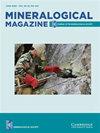具有棕榈岩型结构的矿物。第二部分。掌纹岩超群的命名和分类
IF 1.4
3区 地球科学
Q2 MINERALOGY
引用次数: 1
摘要
本文章由计算机程序翻译,如有差异,请以英文原文为准。
Minerals with a palmierite-type structure. Part II. Nomenclature and classification of the palmierite supergroup
Abstract The palmierite supergroup, approved by the IMA-CNMNC, includes five mineral species characterised by the general crystal-chemical formula XIIM1XM22(IVTO4)2 (Z = 3). On the basis of the crystal-chemical arguments and heterovalent isomorphic substitution scheme M++T6+ ↔ M2++T5+, the palmierite supergroup can be formally divided into two groups: the palmierite group M12+M22+(T6+O4)2, and the tuite group M12+M222+(T5+O4)2. Currently, the palmierite group includes palmierite K2Pb(SO4)2, and kalistrontite K2Sr(SO4)2, whereas the tuite group combines tuite Ca3(PO4)2, mazorite Ba3(PO4)2, and gurimite Ba3(VO4)2. The isostructural supergroup members crystallise in space group R$\bar{3}$m (no. 166). The palmierite-type crystal structure is characterised by a sheet arrangement composed of layers formed by M1O12 and M2O10 polyhedra separated by TO4 tetrahedra perpendicular to the c axis. The abundance of distinct ions, which may be hosted at the M and T sites (M = K, Na, Ca, Sr, Ba, Sr, Pb, Rb, Zn, Tl, Cs, Bi, NH4 and REE; T = Si, P, V, As, S, Se, Mo, Cr and W) implies many possible combinations, resulting in potentially new mineral species. Minerals belonging to the palmierite supergroup are relatively rare and usually form under specific conditions, and their synthetic counterparts play a significant role in various industrial applications.
求助全文
通过发布文献求助,成功后即可免费获取论文全文。
去求助
来源期刊

Mineralogical Magazine
地学-矿物学
CiteScore
4.00
自引率
25.90%
发文量
104
审稿时长
6-12 weeks
期刊介绍:
Mineralogical Magazine is an international journal of mineral sciences which covers the fields of mineralogy, crystallography, geochemistry, petrology, environmental geology and economic geology. The journal has been published continuously since the founding of the Mineralogical Society of Great Britain and Ireland in 1876 and is a leading journal in its field.
 求助内容:
求助内容: 应助结果提醒方式:
应助结果提醒方式:


